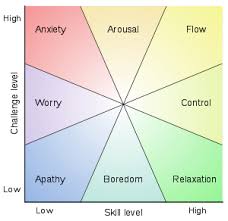In a past article we defined the concept of A Players – the top performers in our organizations. By using a simple two dimensional model to evaluate employees, leaders can separate the A players from the Bs and Cs. Specifically, A players are those people who behave consistently with the company core values AND perform to a high level in their roles.
But once we know who our A Players are, how can leaders keep them engaged in their work for the long term?
Another simple model that can help managers support and coach employees to optimize engagement and retention was created by Mihaly Csikszentmihalyi and described in his book “Flow: The Psychology of Optimal Experience“. In this book, Csikszentmihalyi describes a 2 x 2 matrix for understanding emotional responses to activities. The two dimensions are, (1) the task’s perceived level of challenge, and (2) the level of competency or skill required. Csikszentmihalyi shows that the optimal experience for people lays in the high-high zone which he calls “flow”. When people are operating in flow, they are highly gratified, satisfied and engaged in the work they are doing.
However leaders must recognize that a particular task or activity for an employee will not remain in the same position in the model over time. Sometimes a new task may begin in the High Challenge/Low Skill zone as an employee is asked to do something they have not done before. Over time and with experience, skill grows moving the task closer to the flow zone. As even more time passes, that particular task may lose challenge for the employee and drop into the areas of boredom or even apathy.
Two considerations for delegation
Putting this model into action occurs when opportunities arise to delegate tasks or projects to team members in the organization. Deciding who to assign is a question of attitude and aptitude:
Does the person I am considering have the right aptitude?:
- Do they have the skill to execute the task or project?
- Do they have the experience in this or similar undertakings?
- If the skill is not present, what resources, support and coaching can be provided to help the individual?
- What other activities could suffer if the individual takes on this activity? Do other responsibilities need to be reallocated?
- How much time does the individual have to acquire the needed skills?
- How much tolerance is there for mediocre execution?
This final point is particularly important. Leaders may need to allow some failure or mistakes to occur in order for learning to take place. People often learn from their mistakes. Knowing how much tolerance there is for error on a particular task is crucial for effective delegation.
Does the person I am considering have the right attitude?:
- Will this be a challenge for for the individual, or is it simply routine?
- Is this person an ambitious learner willing to take on something they may not be good at initially?
- Does the individual understand the “big picture” and how this particular activity or project links to the overall strategy of the firm?
- Does this task or project have the potential to move the person into the flow experience?
Maintaining a team of high performers
Successful organizations achieve greatness by applying the skills, energy and focus of their people, particularly their A-Players. There is no question great leaders have the ability to identify and attract these individuals. But just as important is keeping them engaged, focussed and excited over time. To do this, leaders must match employees to activities that create an optimal experience by looking for opportunities to balance both skill and challenge.
Article by: Tim O’Connor
Image from: http://en.wikipedia.org/wiki/Flow_(psychology)


